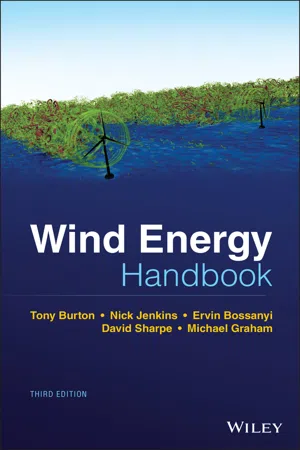
Wind Energy Handbook
- English
- ePUB (mobile friendly)
- Available on iOS & Android
Wind Energy Handbook
About this book
Fully updated and authoritative reference to wind energy technology written by leading academic and industry professionals
The newly revised Third Edition of the Wind Energy Handbook delivers a fully updated treatment of key developments in wind technology since the publication of the book's Second Edition in 2011. The criticality of wakes within wind farms is addressed by the addition of an entirely new chapter on wake effects, including 'engineering' wake models and wake control. Offshore, attention is focused for the first time on the design of floating support structures, and the new 'PISA' method for monopile geotechnical design is introduced.
The coverage of blade design has been completely rewritten, with an expanded description of laminate fatigue properties and new sections on manufacturing methods, blade testing, leading-edge erosion and bend-twist coupling. These are complemented by new sections on blade add-ons and noise in the aerodynamics chapters, which now also include a description of the Leishman-Beddoes dynamic stall model and an extended introduction to Computational Fluid Dynamics analysis.
The importance of the environmental impact of wind farms both on- and offshore is recognized by expanded coverage, and the requirements of the Grid Codes to ensure wind energy plays its full role in the power system are described. The conceptual design chapter has been extended to include a number of novel concepts, including low induction rotors, multiple rotor structures, superconducting generators and magnetic gearboxes.
References and further reading resources are included throughout the book and have been updated to cover the latest literature. As in previous editions, the core subjects constituting the essential background to wind turbine and wind farm design are covered. These include:
- The nature of the wind resource, including geographical variation, synoptic and diurnal variations, and turbulence characteristics
- The aerodynamics of horizontal axis wind turbines, including the actuator disc concept, rotor disc theory, the vortex cylinder model of the actuator disc and the Blade-Element/Momentum theory
- Design loads for horizontal axis wind turbines, including the prescriptions of international standards
- Alternative machine architectures
- The design of key components
- Wind turbine controller design for fixed and variable speed machines
- The integration of wind farms into the electrical power system
- Wind farm design, siting constraints, and the assessment of environmental impact
Perfect for engineers and scientists learning about wind turbine technology, the Wind Energy Handbook will also earn a place in the libraries of graduate students taking courses on wind turbines and wind energy, as well as industry professionals whose work requires a deep understanding of wind energy technology.
Frequently asked questions
- Essential is ideal for learners and professionals who enjoy exploring a wide range of subjects. Access the Essential Library with 800,000+ trusted titles and best-sellers across business, personal growth, and the humanities. Includes unlimited reading time and Standard Read Aloud voice.
- Complete: Perfect for advanced learners and researchers needing full, unrestricted access. Unlock 1.4M+ books across hundreds of subjects, including academic and specialized titles. The Complete Plan also includes advanced features like Premium Read Aloud and Research Assistant.
Please note we cannot support devices running on iOS 13 and Android 7 or earlier. Learn more about using the app.
Information
1
Introduction
1.1 Historical development of wind energy
Table of contents
- Cover
- Table of Contents
- Title Page
- Copyright
- About the Authors
- Preface to Second Edition
- Preface to Third Edition
- Acknowledgements for the First Edition
- Acknowledgements for the Second Edition
- Acknowledgements for the Third Edition
- List of Symbols
- Figures C1 and C2 – coordinate systems
- 1 Introduction
- 2 The wind resource
- 3 Aerodynamics of horizontal axis wind turbines
- 4 Further aerodynamic topics for wind turbines
- 5 Design loads for HAWTs
- 6 Conceptual design of horizontal axis wind turbines
- 7 Component design
- 8 The controller
- 9 Wake effects and wind farm control
- 10 Onshore wind turbine installations and wind farms
- 11 Wind energy and the electric power system
- 12 Offshore wind turbines and wind farms
- Index
- End User License Agreement